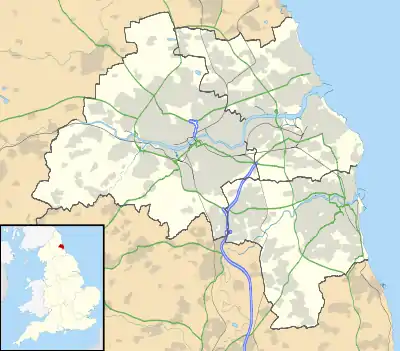Elswick, Tyne and Wear
Elswick (/ˈɛlzɪk/ EL-zik[1]) is an area and ward of the city of Newcastle upon Tyne, England, 1.9 miles west of the city centre,[2] bordering the River Tyne. Historically in Northumberland, Elswick became part of Newcastle in 1835. In 2018 it had an estimated population of 15,869.[3] The usual resident population of the ward in 2011 was 13,198, 4.7% of the total population of Newcastle upon Tyne, comprising 5,116 households.[4] The ward profile shows Elswick is the ward with the highest percentage of children under 14 years in Newcastle and has a lower than average number of senior citizens (10%) than Newcastle as a whole. Elswick has a lower than average number of houses in owner-occupation (26.3% compared with 49.9% for Newcastle city).[4]
| Elswick | |
|---|---|
 Elswick Location within Tyne and Wear | |
| OS grid reference | NZ228633 |
| • London | 242 miles (389 km) |
| Metropolitan borough | |
| Metropolitan county | |
| Region | |
| Country | England |
| Sovereign state | United Kingdom |
| Post town | NEWCASTLE UPON TYNE |
| Postcode district | NE4 |
| Dialling code | 0191 |
| Police | Northumbria |
| Fire | Tyne and Wear |
| Ambulance | North East |
| UK Parliament | |
| Councillors | |
History
In Roman times the Vallum, a defensive barrier behind Hadrian's Wall, reached its easternmost limit in Elswick. The Wall itself carried on as far as Wallsend.
The township of Elswick had originally formed part of the Barony of Bolam and was owned by Tynemouth Priory from 1120-1539, with a fishery present on the site.[5] One of the earliest references to the coal mining industry of the north east occurs in 1330, when it was recorded that the Prior of Tynemouth let a colliery, called Heygrove, at "Elstewyke" for a rent of £5 per year. Elswick Colliery had 3 pits working from 1860 onwards.[6] Elswick was owned by the Crown from 1539 to 1628, until it was sold by Charles I.
The Priors held a mansion in the middle of Elswick which was later occupied by Elswick Hall. Having been rebuilt a number of times, the last rebuild took place in 1810. The grounds of Elswick Hall became Elswick Park in 1881.[7] Elswick changed significantly in the late 19th century with the extension of the railway from Carlisle to Newcastle in 1839 and the establishment of Armstrong's manufacturing works in 1847.[8] Population increased rapidly during this period, from about 300 in 1801 to 59,165 in 1901.[9] Tyneside flats were built in the area around Scotswood Road to accommodate the workforce.
The Elswick works was founded in 1847 by engineer William George Armstrong.[10] It manufactured hydraulic machinery, cranes and bridges and, later, artillery. In 1882 the company merged with the shipbuilding firm of Charles Mitchell to form Armstrong, Mitchell & Company. Armstrong Mitchell merged again with the engineering firm of Joseph Whitworth in 1897, forming Armstrong, Whitworth & Co.[11]
Elswick station was opened in 1889 to serve the area. It was located at the western end of the Elswick Works, whose workforce made up a significant proportion of travellers. The area suffered as a result of the inter-war and subsequent depressions, culminating in the demolition of the Elswick works. The station was closed and then demolished in 1967.[12]
Elswick was hit hard by the decline of Tyneside's shipbuilding industry during the second half of the 20th century, and by the 1990s was widely regarded as one of the worst parts of Tyneside, if not the whole of Britain. According to a report by The Independent newspaper, unemployment stood at nearly 30% and the area had a widespread problem with drug abuse and arson attacks.[13]
Elswick today
Present day Elswick consists of a number of distinct neighbourhoods including the Adelaide Terrace area, Bentinck Estate, Condercum and Denhill Park, Cruddas Park (part renamed Riverside Dene), Elswick Triangle, Gill Street and the Courts, Grainger Park, Jubilee Estate, North Benwell, and both from the St John's and St Paul's areas. The local authority ward also incorporates South Central Station, Newcastle Business Park, Newcastle College, and the Utilita Arena Newcastle. As of the 2011 census, Elswick had one of the lowest White populations in Newcastle at around 55% with a large Asian population of 33.4% (including 15.9% Bangladeshi, 8.3% Pakistani), and 5.6% Black or Black British. Elswick has a large Muslim population of 31.9% and a Christian population of 43.4%.[5][3]
Elswick's Location
Located on a height of 53.1m, Elswick overlooks the River Tyne and is a suburban area in the West End of Newcastle upon Tyne.
References
- "Elswick - 25 Years On". Retrieved 25 May 2020.
- Chisholm, Hugh, ed. (1911). . Encyclopædia Britannica. 9 (11th ed.). Cambridge University Press. p. 300.
- "Elswick (Ward, United Kingdom) - Population Statistics, Charts, Map and Location". www.citypopulation.de. Retrieved 31 December 2020.
- Crosby, Louise. "Elswick Ward in Newcastle upon Tyne". Know Newcastle NFNA. Know Newcastle. Retrieved 22 July 2014.
- "Elswick 'Where I live'". Newcastle Ward website. Newcastle City Council. Archived from the original on 29 July 2014. Retrieved 22 July 2014.
- "Elswick Colliery - DMM".
- Archived 29 September 2013 at the Wayback Machine
- "Exhibitions". www.ncl.ac.uk.
- Morton, David (17 March 2017). "Charting the rise of Elswick in Newcastle over time". ChronicleLive. Retrieved 31 December 2020.
- Morton, David (27 September 2017). "10 things to know about Benwell, Elswick and Scotswood". ChronicleLive. Retrieved 31 December 2020.
- "Armstrong Mitchell Elswick Shipbuilder". Tynebuiltships.co.uk. Retrieved 11 December 2015.
- "Elswick Station". Disused Stations. Retrieved 11 December 2015.
- "No-Go Britain: Where, what, why". independent.co.uk.
External links
| Wikimedia Commons has media related to Elswick, Newcastle upon Tyne. |